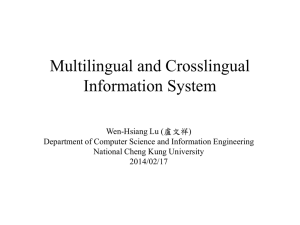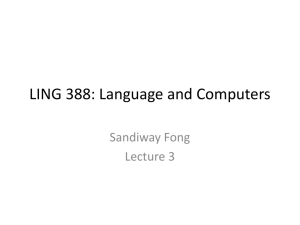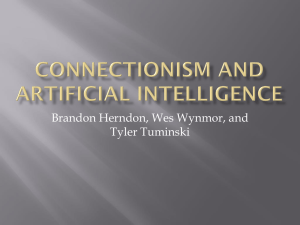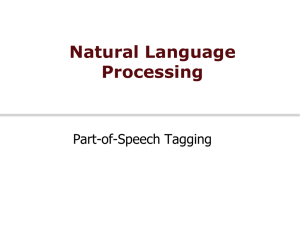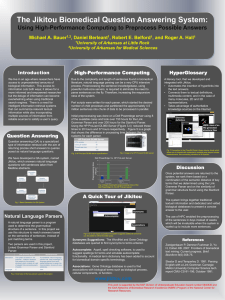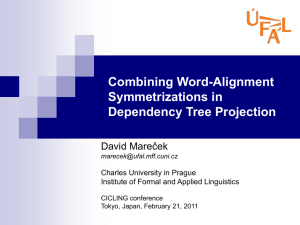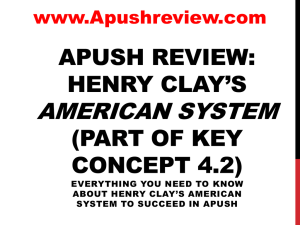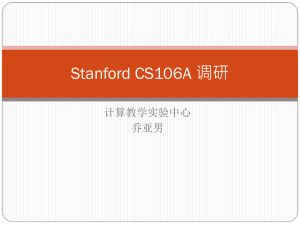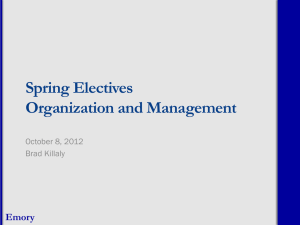lecture2
advertisement
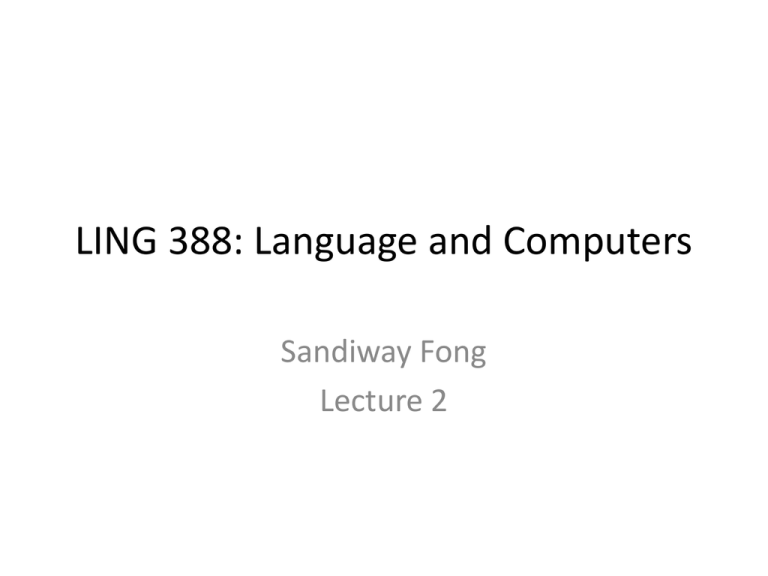
LING 388: Language and Computers Sandiway Fong Lecture 2 Administrivia • Lab Exercises Today • Homework 1 is out today – due next Monday by midnight – I’ll go over the homework in class next Tuesday Example from Last Time • Ambiguity – Where can I see the bus stop? – stop: verb or part of the noun-noun compound bus stop – Context (Discourse or situation) http://www.clker.com Example from Last Time each word is given a POS label tree diagram of the sentence in S-EXP format http://nlp.stanford.edu:8080/parser/ Example from Last Time • POS Tagging: Parts of Speech (POS) Tagset (Penn Treebank) https://www.ling.upenn.edu/courses/Fall_20 03/ling001/penn_treebank_pos.html Example from Last Time • S-EXP Parse: 1. (PHRASE S-EXP1 .. S-EXPn) 2. (POS WORD) Tagset (Penn Treebank) http://www.ldc.upenn.edu/Catalog/docs/LD C95T7/cl93.html S-EXP1 S-EXP2 e.g. (VP (VB see) (NP … ) e.g. (NN bus) Example from Last Time • Phrase tagset: http://www.uniml.com/pmwiki Example from Last Time • Typed dependencies between words in a sentence form a graph: – relation(Word1,Word2) – Word2 modifies Word1 – Example: nsubj(see,I) – “I modifies see: I is the nominal subject of see” where advmod root see can aux nsubj ROOT dobj stop det nn 7 relations = 7 arcs in the graph I the Explanation of the relations used can be found in http://nlp.stanford.edu/software/dependencies_manual.pdf bus Example from Last Time • Comparison (parse vs. typed dependency graph): where advmod root see can ROOT dobj aux stop nsubj det nn I the bus Exercise 1 • Consider the syntactically ambiguous sentence: – I prodded the boy with a stick . • What is the ambiguity here? • How can that ambiguity be expressed? • Which interpretation does the Stanford Parser prefer? Exercise 2 • Compare with: – The boy with a stick prodded me. • Why is this sentence not similarly ambiguous? • Does the Stanford Parser give the right parse? Exercise 3 • Compare the Stanford parser interpretation for the two sentences: – I prodded the boy with a stick. – I saw the boy with a telescope. • What is the difference? • Can you force the parser to change structure by changing the object of the preposition? Exercise 4 • Contrast the following two sentences: – John is too stubborn to talk to. – John is too stubborn to talk to Bill. • What is missing from the output of the Stanford Parser? Exercise 4 Exercise 4 Homework 1 • Remember the syllabus described last time … – submit by email to your TA Ben Martin bamartin@email.arizona.edu – next Monday (by midnight) – Subject of email should read: LING 388 Homework 1 – Put your name at the top of the file – Collect all answers in one file • plain text or PDF formats only please (not .docx) • should you choose to include any screen snapshots or illustrations to support your answer, they should not be in separate attachments – make them part of your single document Homework 1 Examine the Stanford Parser output on these two sentences: 1. Which car did Mary like? 2. *Which car did Mary like the convertible? Questions: 1. (4pts) Does the typed dependencies output offer any advantage over the parse output for the 1st sentence? 2. (4pts) What is wrong with the 2nd sentence? 3. (4pts) Is it possible to deduce from the Stanford Parser output that the 2nd sentence is ungrammatical? Homework 1 Review • Recall the ambiguous example: – Where can I see the bus stop? the Stanford parser analyses “bus stop” preferentially as a noun-noun compound: (NP (DT the) (NN bus) (NN stop)) 4. (4pts) Give a (question) sentence ending in “… the bus stop?” where the Stanford parser analyses “stop” as a verb. 5. (4pts) What syntactic situations would force a parser to decide to analyze “stop” in “… the bus stop?” as a noun (vs. a verb)? Homework Resources • Tagset (Penn Treebank) – Parts of speech (POS) – https://www.ling.upenn.edu/courses/Fall_2003/ling0 01/penn_treebank_pos.html – More detailed, including syntactic labels – http://www.ldc.upenn.edu/Catalog/docs/LDC95T7/cl9 3.html • Dependencies – http://nlp.stanford.edu/software/dependencies_man ual.pdf
